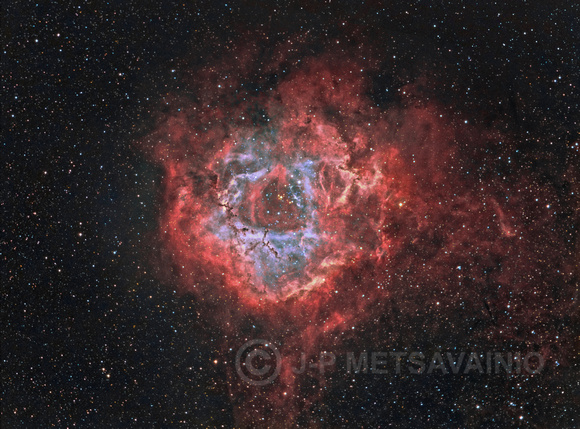Caldwell 49, the "Rosette Nebula"
Natural color composition from the emission of ionized elements, R=80%Hydrogen+20%Sulfur, G=100%Oxygen and B=85%Oxygen+15%Hydrogen to compensate otherwise missing H-beta emission. This composition is very close to a visual spectrum.
The Rosette Nebula (also known as Caldwell 49) is a large, circular H II region located near one end of a giant molecular cloud in the Monoceros. The open cluster NGC 2244(Caldwell 50) is closely associated with the nebulosity, the stars of the cluster having been formed from the nebula's matter. The cluster and nebula locates at a distance of about 5,200 light years from Earth. The diameter is about 130 light years.
The radiation from the young stars ionized the atoms in the nebula, causing them to emit light, typical to each element, producing the visible nebula. Stellar winds, radiation pressure, from a group of stars cause compression to the interstellar clouds, followed by star formation in the nebula. This star formation is currently still ongoing.
Processing work flow:
Image acquisition, MaxiDL v5.07.
Stacked and calibrated in CCDStack.
Deconvolution with a CCDSharp, 20 iteration, added at 50% weight.
Levels, curves and color combine in PS CS3.
Equipments:
Tokina AT-a 300mm f2.8 @ f2.8
Platform and guiding, Meade LX200 GPS 12" @ f5
Camera, QHY9
Guider, Lodestar
Image Scale, 3,83 arcseconds/pixel
Exposures:
Baader H-alpha 7nm 15x1200s, binned 1x1 (5h)
Other channels are from an older image:
http://astroanarchy.blogspot.com/2011/01/cone-and-rosette-nebulae-reprocessed.html


